Ever wondered how much an average lawn mower weighs?
Me too. So I’ve been analyzing lawn mower statistics to give you the breakdown of lawn mower weights. If you’ve been wondering about how much your next mower might weigh, you’ve come to the right place.
With data from Mowersdirect, I’ve gathered up the numbers and analyzed 42 different lawn mowers. Below you’ll find all you’ll need to know about weight differences for mower types, electric vs. gas mower weights, and info on price and cutting width weight correlations.
First, I’ll give you a quick summary of our findings before diving into a few graphs showing our weight comparisons. Then we’ll wrap things up with an overview of the different types of mowers in our analysis.
Are you ready to weigh up our mowers? Let’s get going!
Lawn Mower Weights Summary
| Lawn Mower Type | # Reviewed | Average Weight | Average Price | Average Width |
| Reel | 7 | 30lbs | $125 | 17in |
| Self-Propelled | 14 | 85lbs | $605 | 22in |
| Rough Cut | 8 | 325lbs | $3,220 | 26in |
| Zero Turn | 9 | 610lbs | $3,260 | 51in |
| Semi Pro | 4 | 755lbs | $4,675 | 52in |
Electric vs Gas Lawn Mower Weights
Let’s get started on some numbers.
The graph below shows the weights of both electric and gas lawn mowers plotted against purchase cost.

As we can see, gas models have a larger price range, and tend to be heavier. We have both the cheapest and most expensive models in our analysis. The electric models have less of a range than the gas, but start off at a more expensive price point than their gas-powered cousins.
When it comes to the weights, we can see that electric models are generally lighter (since they don’t have an engine to carry around). Although, the most expensive electric model is heavier than some of the cheaper gas ones.
Lawn Mower Weight vs Price
Our next analysis looks at the relationship between lawn mower weight and cost.
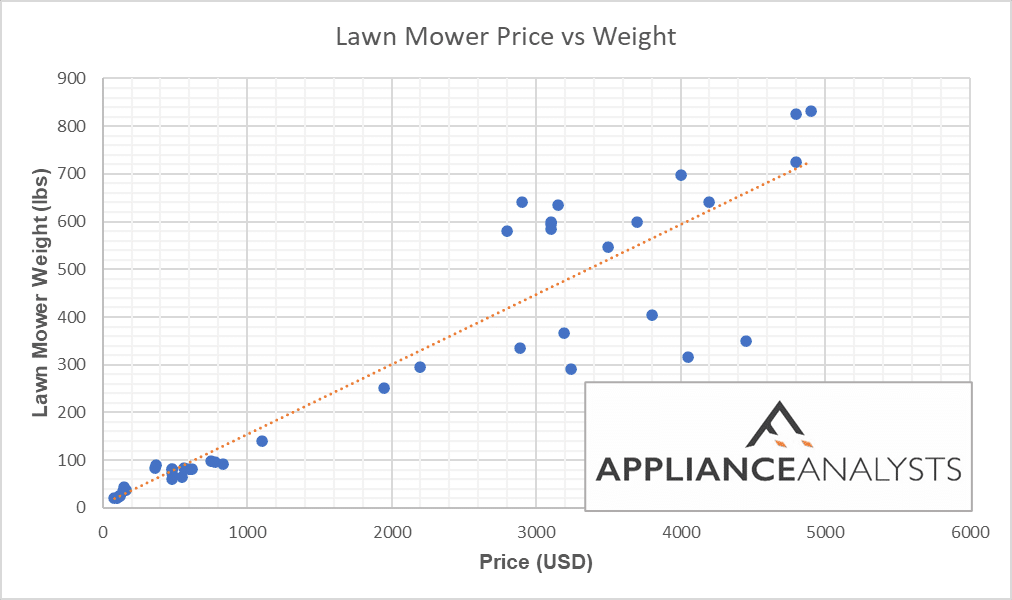
There is quite a large standard deviation (the difference from the average for each data point) on this graph. But it is obvious that in general, the price goes up as weight does. The most expensive mowers are also the heaviest, as we might expect, with bigger engines and heavier-duty parts costing more.
Cutting Width vs Weight
Our next graph is a comparison of cutting width and weight.
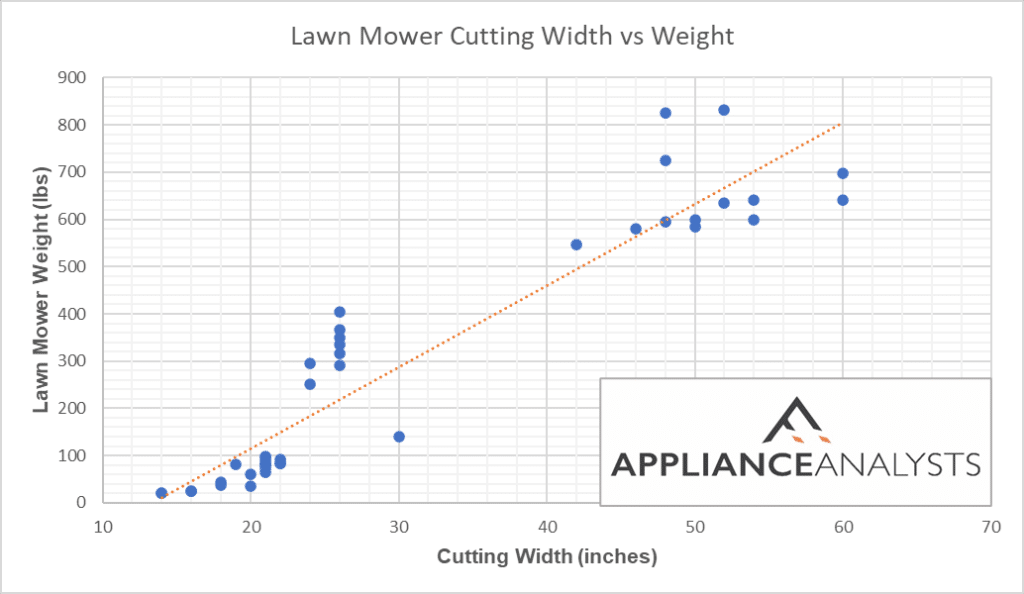
As expected, there is a good correlation between increased cutting width and increased weight. And there is not so much deviation from the average as there was with cost vs weight.
An interesting side note is the clear differentiation between walk-behind mowers and ride-on mowers. With 30 inches being the maximum self-propelled cutting width in our test. Whereas the ride-on mowers have a minimum 42-inch cutting width rising to a sizeable 60 inches for the largest.
Lawn Mower Types Breakdown
Now that you’ve seen the numbers, let’s take a quick look at the types of mowers we’ve analyzed:
Reel
A reel mower cuts the grass using a bladed cylinder that rotates around the vertical axis. Usually, these are manually pushed (although you can get larger ones that are pulled by tractors). They are great for small, even lawns.
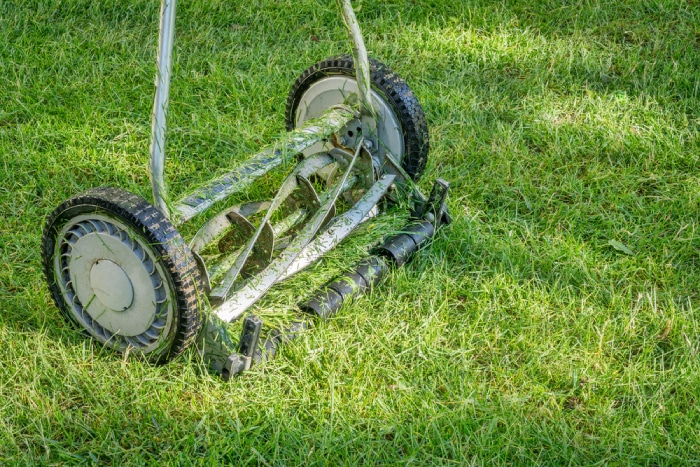
Reel mowers are both the lightest and cheapest, with an average weight of only 30 lbs and an average price of $125. But they also have the smallest cutting width at 17 inches.
Pros
- Cheap.
- No noise or exhaust gases from manually pushed versions.
- Very safe to use.
- Actually healthier for your grass. The vertical rotating blades act almost like scissors, cutting the grass cleanly and helping to increase the lawn’s resistance to disease. This is the reason you will often see golf courses being cut with large reel mowers pulled by tractors.
Cons
- Not great on uneven surfaces, tall grass, or with debris like twigs and leaves.
- Needs regular sharpening.
- Small cutting area (on the normal manual versions).
Self-Propelled
A self-propelled mower is a type of mower that takes some of the engine power (or motor on an electric version) to drive the wheels and push the mower forward. Basically, instead of you pushing the mower, you’re getting help from the engine.
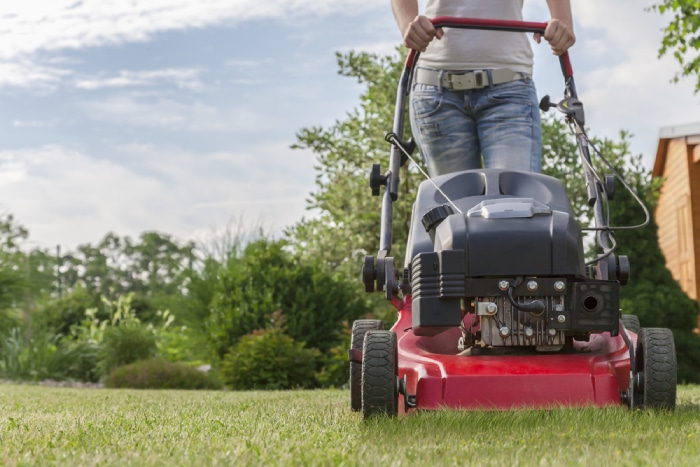
These are the most common types of mower found and are the standard workhorses for most lawn owners. If you have a lawn under half an acre, a self-propelled model is probably your best bet.
Our self-propelled models have an average weight 0f 85lbs, an average price of $605, and an average cutting width of 22 inches.
Pros
- Less effort required to mow your lawn.
- Much easier for sloping lawns.
- Front-wheel, rear-wheel, and all-wheel drive versions available depending on your needs.
Cons
- More expensive than push mowers.
- More complicated than push mowers means there is more to go wrong.
Rough Cut
A rough-cut mower is a heavy-duty mower. Designed to tackle rough terrain and cut rougher, denser grass and weeds. They usually come in two versions: a smaller walk-behind mower for domestic or smaller areas, and a larger pull behind deck for use with a tractor.
Walk-behind rough-cut mowers are much heavier than their normal self-propelled cousins. They have an average weight of 325lbs. The big jump in weight is equaled by a jump in cost, as the rough-cut models have an average price of a sizeable $3,220. The average cutting width is a slightly larger 26 inches.
Pros
- Tackles weeds, debris, twigs, and rough material.
- Often fitted with jumper blades that can handle rocks and roots without damaging the blades or the motor.
- Built to handle rough terrain and cut wooded trails or ditches.
Cons
- Expensive.
- Not as refined a finish as a standard mower.
Zero Turn
A zero-turn mower is a type of sit-on mower that is highly maneuverable and can turn within its own radius. Usually, with quite large cutting decks, these mowers are fast, efficient, and make cutting large lawns a breeze. If you’ve got ¾ of an acre and upwards, then a zero-turn is going to make cutting a lot quicker. But where they really come into their own is on large irregular-shaped lawns.
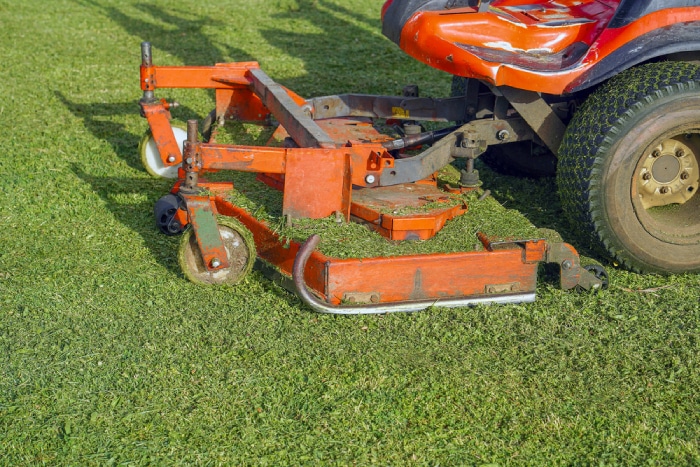
The zero-turn mowers in this test have an average weight of 610 lbs. But an interesting point is that the average price of a zero-turn mower is almost the same as a rough-cut mower at $3,260. Cutting width has jumped to a speedy 51 inches on average.
Pros
- Fastest lawn cutting times.
- Excellent maneuverability.
- Efficient – reduces need for follow-up trimming.
Cons
- Not great for slopes.
- Not great on wet grass.
Semi-Pro
Semi-pro mowers tend to be zero-turn, with some added features not found in the cheaper versions. They are designed for people with large areas to mow and are sometimes used by smaller contractors.
Our final category of semi-pro zero turn models are both heavier and more expensive than the domestic versions. An average weight of 755lbs and an average cost of $4,675 say they mean business. But the cutting width is almost the same at 52 inches.
Pros
- Large cutting deck, fuel-tank, power
- Versatile attachments available
- Heavy-duty build
Cons
- Most expensive non-commercial models.
- Uses more fuel.
Conclusion
So, that’s our lawn mower weight analysis. Here is the table for your convenience:
| Lawn Mower Type | Models Reviewed | Average Weight | Average Price | Average Width |
| Reel | 7 | 30lbs | $125 | 17in |
| Self-Propelled | 14 | 85lbs | $605 | 22in |
| Rough Cut | 8 | 325lbs | $3,220 | 26in |
| Zero Turn | 9 | 610lbs | $3,260 | 51in |
| Semi Pro | 4 | 755lbs | $4,675 | 52in |
As you can see, there is a mower for every type of lawn.
- Small and flat – Reel
- Up to ½ ¾ of an acre – Self-propelled
- Rough terrain or lots of debris – Rough cut
- Large lawns – Zero-turn / Semi-pro
From our analysis, we can see there is a pretty linear increase in weight, cost, and cutting width from our smallest reel mowers right up to the big and powerful semi-pro zero-turn models. All you have to do is decide which one is right for you.
I hope you’ve enjoyed our weight breakdown article – how much does a lawn mower weigh? Happy mowing.







